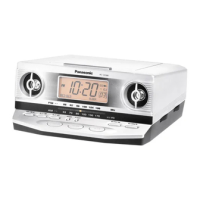What to do if my Panasonic RC-CD300 displays “E”?
- JJacqueline JacksonJul 30, 2025
If your Panasonic Clock Radio displays “E”, it indicates an incorrect operation. Please read the instructions to ensure proper usage.

What to do if my Panasonic RC-CD300 displays “E”?
If your Panasonic Clock Radio displays “E”, it indicates an incorrect operation. Please read the instructions to ensure proper usage.
What to do if play doesn’t start on Panasonic RC-CD300 Clock Radio?
If your Panasonic Clock Radio's play function doesn't start or the display is incorrect, you can try the following: 1. Clean the CD. 2. Wait an hour to allow any condensation to dry, then try again. 3. Ensure the CD label is facing up. 4. Replace the CD if it's scratched, warped, or irregularly shaped.
Why doesn't the alarm sound on my Panasonic RC-CD300?
If the alarm on your Panasonic Clock Radio doesn’t sound at the set time, make sure that the alarm indicator (“AL 1” or “AL 2”) is turned on.
How to fix “ – – – – ” on Panasonic Clock Radio?
If your Panasonic Clock Radio displays “ ” or “ – – – – ”, you should set the current time. Also, make sure that a CD has been inserted.
| FM frequency range | 87.5–108.0 MHz |
|---|---|
| AM frequency range | 525–1710 kHz |
| Decoding | 16 bit linear |
|---|---|
| Beam source | Semiconductor laser (wavelength 780 nm) |
| Number of channels | 2 channel, stereo |
| Power requirement | AC 120 V, 60 Hz |
|---|---|
| Power consumption | 14 W |
| Memory back-up | 9 V (One 6F22/6LR61, 006P battery) |
| Dimensions | 232k107k215 mm |
|---|---|
| Mass | 1.55 kg (3 lb 6.7 oz) without battery |
| Speakers | 4.5 cm (1[3]/4q) 6 ≠k2 |
Covers power, cord protection, overloading, nonuse, attachments, and accessories.
Details placement, ventilation, foreign material, magnetism, stacking, surface, carts, wall mounting, water, moisture, and heat.
Outlines cleaning, damage requiring service, and replacement parts.
Explains caution symbols for electric shock and importance of instructions.
Identifies buttons for CD/radio modes, playback, and tuning.
Identifies buttons for alarm, sleep timer, display, and doze functions.
Instructions for opening lid, inserting disc, starting, stopping, pausing, and volume.
Covers skip, search, repeat, and random play functionalities.
Steps for selecting bands, tuning stations, and adjusting volume.
Tips for FM/AM antenna adjustment and mono mode.
Guides setting up the first alarm using CD or radio.
Guides setting up the second alarm using a buzzer.
Details stopping, snoozing, checking, and clearing alarm settings.
Addresses common display errors, alarm failures, CD playback, and radio noise.
Details warranty periods for parts and labor for various product types.
Lists conditions and damages not covered by the warranty.
Outlines conditions requiring service and post-repair safety checks.
Instructions for cleaning the CD player lens.
